 Inspired by. George Nafziger's
lecture and related discussions on
skirmishers at last summer's Historicon, I
delved into my copy of "A Concise System
of Instruction and Regulations for THE
MILITIA AND VOLUNTEERS of the United
States, Comprehending THE EXERCISES
AND MOVEMENTS of The Infantry, Light
Infantry, and Riflemen; Cavalry and
Artillery" for its instructions regarding
the deployment and use of skirmishers.
This text was "Prepared and Arranged by
BREVET CAPTAIN S. COOPER, Aide de
Camp and Assistant Adjutant General,
Under the Supervision of Major General
Alexander Macomb, Commanding the
Army of the United States" and published
in Philadelphia by Robert P. Desilver, in
1836.
Inspired by. George Nafziger's
lecture and related discussions on
skirmishers at last summer's Historicon, I
delved into my copy of "A Concise System
of Instruction and Regulations for THE
MILITIA AND VOLUNTEERS of the United
States, Comprehending THE EXERCISES
AND MOVEMENTS of The Infantry, Light
Infantry, and Riflemen; Cavalry and
Artillery" for its instructions regarding
the deployment and use of skirmishers.
This text was "Prepared and Arranged by
BREVET CAPTAIN S. COOPER, Aide de
Camp and Assistant Adjutant General,
Under the Supervision of Major General
Alexander Macomb, Commanding the
Army of the United States" and published
in Philadelphia by Robert P. Desilver, in
1836.
Captain Cooper graduated from West Point in December, 1815, and wrote this volume in 1836 while assistant to the Adjutant General of the United States Army. Cooper's work reportedly reflects French practice of the late-Napoleonic period, based upon commentary from George Nafziger (among others) that the American army at this time was primarily influenced by the French example. However, I am still seeking to identify the foreign sources upon which Cooper may have drawn.
The text is intended as a manualfor the use of militia officers and men in learning basic maneuvers and duties. It is divided into sections for line infantry, light infantry and riflemen, cavalry, and artillery, with a concluding section of general regulations governing proper military behavior. This article draws principally on the instructions for the maneuver and placement of skirmishers.
1. Deployment of Light Infantry and Rifle Companies as Skirmishers
A company deploying as skinnishers is first divided into three platoons. If behind the position to be occupied as skirmishers, the left and right hand platoons deploy forward; if already on the line to be held as skirmishers, these two platoons deploy to their respective right and left flanks. The 3rd or center platoon holds its original position, or moves back to take position as company reserve, remaining in close formation.
The front...to cover a battalion, comprehends the front of the battalion and half of each interval on [its] right and left....
A company may be deployed as skirmishers, either forward, or by the flank. It is deployed forward, when it is behind the line on which it is to be established (figure 1); and by the flank when already on that line (figure 2). In both cases it is divided into three platoons: the right and left platoons...form the line of skirmishers; the center platoon [forms] the reserve.
2. Positioning Skirmishers
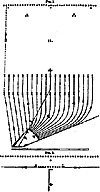 Skirmishers are expected to
take advantage of terrain while
attempting to retain some semblance to a line
formation. The intervals or gaps between
individual skirmishers in the same rank
or line should not be more than thirtyfive
feet.
Skirmishers are expected to
take advantage of terrain while
attempting to retain some semblance to a line
formation. The intervals or gaps between
individual skirmishers in the same rank
or line should not be more than thirtyfive
feet.
A line of skirmishers ought, as far as possible, to be aligned; but to obtain this regularity, advantages which the ground may present for covering the men, ought not to be neglected....The intervals between files of skirmishers depend on the extent of the ground to be covered; but they should not exceed ten, or at most, fifteen paces [a pace equals twenty-eight inches].
3. Skirmishing Pairs and the Reserve
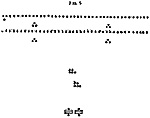 Deployed skirmishers should
be in two ranks, with the second rank
man standing two paces, about four feet,
to the left of the man in the front rank.
This also creates the pairings reportedly
used by most Napoleonic-era skirmishers.
The reserve platoon forms the third rank
or line, remaining in close order about
108 yards further back.
Deployed skirmishers should
be in two ranks, with the second rank
man standing two paces, about four feet,
to the left of the man in the front rank.
This also creates the pairings reportedly
used by most Napoleonic-era skirmishers.
The reserve platoon forms the third rank
or line, remaining in close order about
108 yards further back.
When the left guide [the formation's left hand man] arrives at the point where the left of the [skirmish] line is to rest, the captain halts the skirmishers; each rear-rank man immediately places himself two paces on the left of his file-leader;.... At the beginning of the deployment, the third lieutenant marches the reserve, by the shortest line, to about a hundred and forty paces behind the centre of the line of skirmishers, halts, faces it to the front, and maintains it steadily at that distance; the reserve conforms itself to all... movements of the line.
4. Relieving a Company of Skirmishers
The relieving company moves to forty or fifty feet behind the existing skirmish line and then deploys. After deploying into skirmish line, the relieving company passes through the existing skirmish line and takes position some six to ten feet in advance of that line. The departing skirmishers form on their reserve platoon and withdraw. The relief of a line of skirmishers in retreat is done by the relieving skirmishers taking position behind the withdrawing skirmish line, which then passes through the new skirmish line, forms up on its reserve, and withdraws.
The new [relieving] company executes its deployment forward so as to finish...at about twenty paces in rear of the [skirmish] line (figure 6). Arrived at this distance, the files of the new company by command of their captain, throw themselves a few paces beyond the old line and halt; the new line being established, the old company assembles on its reserve.... If the skirmishers to be relieved are marching in retreat, the company thrown out to relieve them, deploys by the flank,...The old skirmishers continue to retire...and after having passed the new line, rally on their reserve.
5. Skirmish Fire
Skirmishers initiate fire on command. Skirmishers work in pairs so that when firing, one in the first rank and the other in the second, so that one always has a loaded weapon ready to fire.
The fire is given either at a halt, or in marching, and alternately by the two men of the same file, who so arrange it between them, that one or the other always has his piece loaded; to this end the right hand [front-rank] man fires and loads; the left hand [rear-rank] man withholds his fire until the first shall have rammed; the second, in his turn, waits, in like manner, for the first, and so on in continuation....Fire at the halt is executed in the same manner...the men are not to remain in the same place whilst reloading, unless covered by some chance object.
This fire, like that at the halt, is executed by the command, commence firing.... At this cornrnand, if the line be advancing, the frontrank man of every line halts, fires, and reloads, before throwing himself forward; the rear-rank man of the same file continues to march eight or ten paces beyond the first, halts, fires, and reloads; the front- rank man, having reloaded, throws himself forward a like distance beyond his rear-rank man, and fires again...and so on in continuation....If the line be marching in retreat, the front-rank man of every file halts, faces about, fires, and then reloads whilst throwing himself to the rear; the rearrank man of the same file continues to march, halts at eight or ten paces beyond the front-rank man, faces about, fires, and then observes just what is prescribed for the front- rank man;....Skirmishers should also be taught to load and fire kneeling and lying.
Marching in retreat, the commander of the skirmisher's takes advantage of any chance object the ground may present, to arrest the march of the enemy as long as possible.
6. Covering A Withdrawal
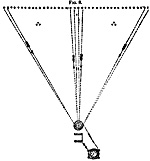 When pressed by
cavalry, skirmishers fall back upon
the reserve platoon, which takes
position as the center-front of the
new formation, each new individual
on arrival taking post on the left or
right flank of the reserve platoon.
As these flanks extend around, they
meet to form the "square" or more
accurately a circle. If the
threatening cavalry allows, the
formation is then reformed into a
column of platoons and falls back
upon its supporting battalion, as
described below.
When pressed by
cavalry, skirmishers fall back upon
the reserve platoon, which takes
position as the center-front of the
new formation, each new individual
on arrival taking post on the left or
right flank of the reserve platoon.
As these flanks extend around, they
meet to form the "square" or more
accurately a circle. If the
threatening cavalry allows, the
formation is then reformed into a
column of platoons and falls back
upon its supporting battalion, as
described below.
This describes the process by which each company of skirmishers falls back on its reserve platoon when threatened by cavalry, and how in a battalion skirmish formation then has each company fall back on the reserve company to form a battalion square if necessary.
A company, deployed as skirmishers, rallies to resist cavalry; ...Rally on the reserve: This command being given, the captain throws himself on the reserve, the chief of which begins the formation of the circle by throwing back a little the two flanks of the reserve. The skirmishers running in, form themselves as they...join the reserve, on its right and left, in two ranks, without regard to height, face outwards and complete the circle (figure 8).
The officers and sergeants direct the execution of the movement, and then place themselves within the circle. These dispositions being made, the captain profits by any interval of time the cavalry may allow him for putting himself in safety against its attacks, either by rejoining his battalion, or by gaining some advantageous position: to this end he...reforms the company into column by platoon, and...he marches in this order....if threatened anew by the cavalry, he halts and again forms circle, by throwing back the flanks of the two platoons; the second....If the suddenness of the attack leave no time to rally the skirmishers on the reserve, the rally is made by platoon; the first and second lieutenants each rallies his platoon on the ground most advantageous behind the line of skirmishers.
Pending the movement, the captain throws himself on the reserve, and so disposes it as to protect the rallying of the platoons and to resist the cavalry. The platoons being rallied, they rejoin the reserve as promptly as possible.
Rally on the battalion: The skirmishers of each platoon and the reserve unmask the front of the battalion, directing themselves, in a run, towards its nearest flank, and then form jr,' its rear. The company being formed, it places itself, for the time, whatever be its designation or number, on the left or right of the battalion, according as it may belong to the left or right wing, and if not a flank company, it will not resume its proper place in line, except by order of the commanding officer.
7. Deploying a Battalion as Skirmishers (Fig. 9)
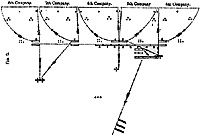 This describes the deployment
of an
entire battalion as skirmishers. Three
companies are deployed forward into a
first line of skirmishers and three into a
second. The sixth company is deployed as
battalion reserve. This does not relieve
ench company of the requirement of
deploying its own reserve platoon. Within
the battalion, each company deploys in
accordance with the principles outlined
for the deployment of an independent
company. This is illustrated in figure 9,
and outlines how each platoon reserve is
deployed within the battalion formation .
This describes the deployment
of an
entire battalion as skirmishers. Three
companies are deployed forward into a
first line of skirmishers and three into a
second. The sixth company is deployed as
battalion reserve. This does not relieve
ench company of the requirement of
deploying its own reserve platoon. Within
the battalion, each company deploys in
accordance with the principles outlined
for the deployment of an independent
company. This is illustrated in figure 9,
and outlines how each platoon reserve is
deployed within the battalion formation .
A company of skirmishers (100 men) thus covering a front of 100 paces (about 233 feet), a battalion would create a cloud of skirmishers covering an area of over 65,000 square fees. The front rank of about thirty skirmishers would be deployed with about eight feet between each man.
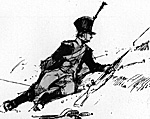 The second rank would be
about twenty-five feet behind the first,
with similar intervals between individuals
in this line. The 3rd platoon in reserve is
some 300 feet from the first line of
skirmishers.
The second rank would be
about twenty-five feet behind the first,
with similar intervals between individuals
in this line. The 3rd platoon in reserve is
some 300 feet from the first line of
skirmishers.
The commanding officer.... indicates to the lieutenant-colonel the direction to be given to the [skirmish] line,...and to the major, the position in which to establish the reserve. The lieutenant-colonel throws himself eight or ten paces before the right of the sixth company, and the adjutant, a like distance before its left.
The battalion being in line, it is supposed to consist of but eight companies, and that it is to deploy on the sixth company holding the three right companies in reserve. This example will serve for a battalion of ten, or any other number of companies. Each company, deployed as skirmishers, is supposed to occupy a front of one hundred paces.
At the [preparatory] command, the sixth and fifth captains march their companies eight or ten paces forward...and give the preparatory commands for deploying forward.... The fourth captain causes [his] company to face to the right, the seventh and eighth captains [face1 their companies to...the left....At the word [quick] march, the movement commences. The sixth and fifth companies deploy forward; the right guide of the sixth [reserve company], directing himself on the point indicated to him by the lieutenantcolonel.
The companies which have faced to the right and left, march straight forward. The fourth [company] takes its interval of a hundred paces from the left file of the fifth [company] and then deploys forward on its left file; the seventh and eighth [companies], each takes the like interval from the nearest file of the company next on its right, and then deploys forward on its right file. Each of the five companies deploys [its skirmishers] according to the principles prescribed for a.... company, and those on the right and left of the sixth and fifth, are each aligned on these central companies, the first deployed.
The company reserves are established as echelons in respect to each other, as follows: the reserve of the sixth, at a hundred and forty paces behind the right of its skirmishers: the reserves of the fourth and fifth, united, opposite to the interval between their skirmishers, and thirty paces nearer the line than the reserve of the sixth; the reserves of the seventh and eighth, also united, opposite to the interval between their skirmishers, and thirty paces farther from the line than the reserve of the sixth.
8. Skirmishing Battalion in
Withdrawal
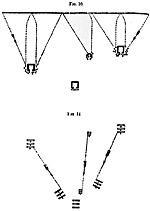
To rally the battalion deployed as skirmishers [when threatened by cavalry] . . . .The companies. ..rally. ..on their respective reserves: each reserve [platoon] forms the first front of the square; the skirmishers who rally first form the lateral fronts, and the other files the fourth front. The officers and sergeants...form the men, as they successively arrive, into two ranks, without regard to height, and cause them to face outward. The rally being effected, the commanders of the company squares...profit by any interval...[the] cavalry may allow for putting them in safety, either by marching upon the battalion reserve, or by taking an advantageous position: to this end, each of these squares is formed into column, and marched in this order, and if threatened anew, it halts, and again forms itself into square....
As the companies successively arrive near the battalion reserve, each reforms as promptly as possible, and without regard to designation or number, takes the place in the column next in rear of the companies already in it.... does reveal some interesting differences clearly reflecting the difference in mobility.
[Cavalry] Skirmishers are usually employed to gain time, to watch the movements of the enemy, to keep him in check, and to prevent him from approaching so close to the main body as to annoy the line of march. On service, regularity in skirmishing and correctness of distance cannot always be maintained, on account of the movements of the enemy and the nature of the ground....On ordinary occasions a few mounted men may be sufficient for this duty; yet it is frequently necessary on service to employ whole squadrons as skirmishers.
The following embraces a company, which is deemed to be sufficient to cover the front and flanks of a regiment composed of three squadrons. One of the flank companies is usually employed for this purpose....LEFT COMPANY OF THE THIRD SQUADRON, SKIRMISH TO THE FRONT MARCH....At the word MARCH, the company named moves forward ten paces, and the men deploy as skirmishers, extending so as to cover the whole front of the squadron, as well as its flanks; for this purpose, the man on the right of the front-rank moves in an oblique direction, towards a point sixty paces in advance, and beyond the right-flank of the regiment; the man on the right of the rear-rank follows his fileleader, and then moves to his left on the same alignment; the other files conform themselves to this movement, placing themselves at equal intervals from each other....In advancing, the skirmishers draw the left pistol, the sword hanging to the wrist.
When the regiment is advancing, the forward march is sounded, when the skirmishers move forward, and at the sound commence firing, they begin the fire. When the halt is sounded, the skirmishers halt, and observe the movement of the regiment, to which they conform. If it turns to the right, or left, they do the same singly, to cover the front; if the regiment retires, the march in retreat is sounded, when the skirmishers retire by a checquered movement, as follows: All the skirmishers who belong to the front-rank wheel about singly to the left, march fifty paces to the rear, and then resume their front by wheeling about singly to the right. The same movements are made by the rear-rank men, who place themselves fifty paces in the rear of the others, and so on as long as the regiment continues in retreat....
When the regiment resumes its front, the halt is sounded, at which the skirmishers halt and form again on the same line. Cease firing is then sounded, and afterwards the rally, when they return by the shortest way to their places in the regiment.
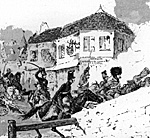 Skirmishers always move out
and return at the gallop: they never
draw their pistols until they are
deployed; they never fire until within
reach of the enemy, unless by order,
and they should always keep their
horses in motion, even when loading,
to avoid becoming a mark to the
enemy. They retire by wheeling
about to the left, and resume their
front by wheeling about to the right.
When they reform again in company,
they return the pistol and carry sword.
Skirmishers always move out
and return at the gallop: they never
draw their pistols until they are
deployed; they never fire until within
reach of the enemy, unless by order,
and they should always keep their
horses in motion, even when loading,
to avoid becoming a mark to the
enemy. They retire by wheeling
about to the left, and resume their
front by wheeling about to the right.
When they reform again in company,
they return the pistol and carry sword.
Back to Empire, Eagles, & Lions Table of Contents Vol. 2 No. 8
Back to EEL List of Issues
Back to MagWeb Master Magazine List
© Copyright 1994 by Emperor's Headquarters
This article appears in MagWeb (Magazine Web) on the Internet World Wide Web.
Other military history articles and gaming articles are available at http://www.magweb.com
